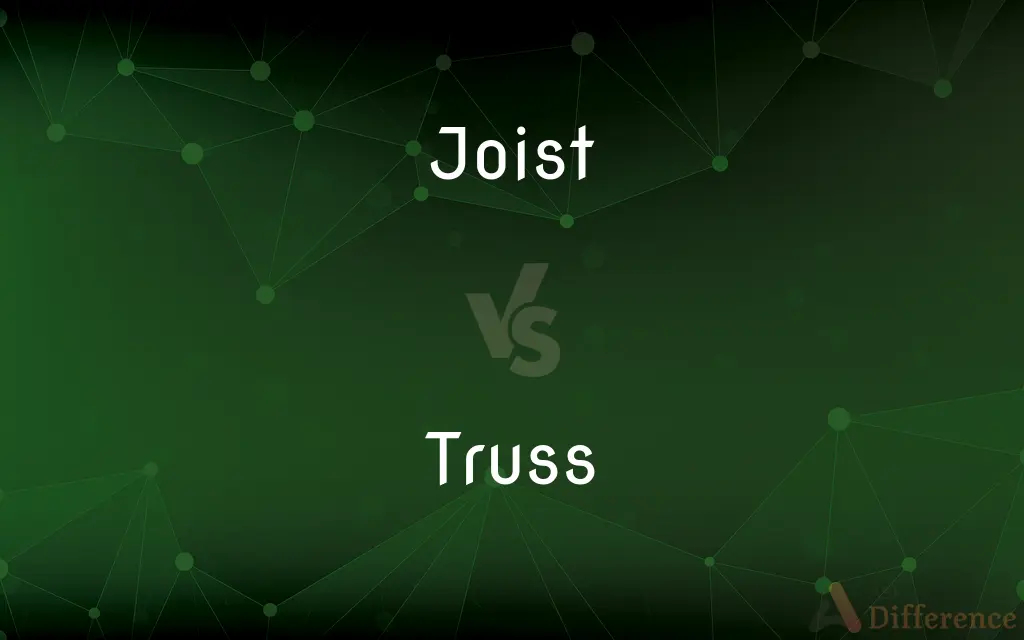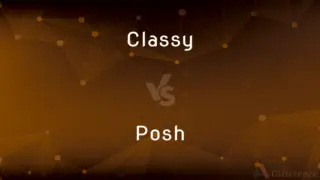Joist vs. Truss — What's the Difference?
By Tayyaba Rehman — Updated on September 22, 2023
A joist is a horizontal structural member supporting floors or ceilings, while a truss is a framework of beams forming triangles, often supporting roofs. Both provide support in building structures.

Difference Between Joist and Truss
Table of Contents
ADVERTISEMENT
Key Differences
Joists and trusses are integral components in construction, each playing a vital role in building stability. A joist, typically made from wood, steel, or concrete, is a horizontal member that spans between walls or beams. Joists are primarily used to support floors and ceilings, distributing the weight of the overhead structure and ensuring even weight distribution across a given area.
On the other hand, trusses are more complex structures. A truss is composed of multiple straight members, usually in the form of triangles, connected at joints known as nodes. The triangular shape of trusses is crucial as triangles are geometrically stable and can distribute loads efficiently. Trusses are most commonly associated with roof structures, providing support for the roof's weight and any additional external loads, such as snow.
The materials used in joists and trusses can vary. While wood is a common material for both, trusses might also incorporate metal elements, especially in larger structures or areas prone to natural disasters. Joists, especially in contemporary buildings, can be made from reinforced concrete or steel, offering enhanced durability and fire resistance.
The installation methods for joists and trusses differ significantly. Joists are typically installed parallel to one another, spaced at regular intervals, and are often continuous across their entire length. Trusses, however, are prefabricated off-site and are brought to the construction site for installation. Because of their design, trusses can span longer distances than individual joists without requiring intermediate support.
Both joists and trusses are fundamental in ensuring a building's structural integrity. While joists support floors and ceilings, trusses provide the framework for roofs, each catering to specific engineering and architectural needs.
ADVERTISEMENT
Comparison Chart
Primary Function
Supports floors and ceilings
Supports roofs
Structure
Horizontal member
Framework of triangles
Common Materials
Wood, steel, concrete
Wood, steel
Installation
Installed parallel at regular intervals
Prefabricated and installed as a unit
Spanning Ability
Typically shorter spans
Can span longer distances without intermediate support
Compare with Definitions
Joist
Often made from wood, steel, or concrete.
The steel joist offers more strength than its wooden counterpart.
Truss
A framework of beams, typically forming triangles.
The roof's truss design allowed it to bear heavy snow loads.
Joist
A horizontal member that supports floors or ceilings.
The wooden joist under the floor began to creak over time.
Truss
Provides support primarily for roofing structures.
We installed a new truss system during the home renovation.
Joist
Structural element evenly distributing weight overhead.
To ensure stability, we installed extra joists in the living room.
Truss
Often prefabricated and then assembled on-site.
The truss units arrived ready for immediate installation.
Joist
Spans between walls or beams in buildings.
The spacing between each joist is crucial for proper load distribution.
Truss
Composed of straight members connected at nodes.
The strength of the truss lies in its triangular configurations.
Joist
Integral to a building's structural framework.
Without proper joist placement, the floor's stability could be compromised.
Truss
A truss is an assembly of beams or other elements that creates a rigid structure.In engineering, a truss is a structure that "consists of two-force members only, where the members are organized so that the assemblage as a whole behaves as a single object". A "two-force member" is a structural component where force is applied to only two points.
Joist
A joist is a horizontal structural member used in framing to span an open space, often between beams that subsequently transfer loads to vertical members. When incorporated into a floor framing system, joists serve to provide stiffness to the subfloor sheathing, allowing it to function as a horizontal diaphragm.
Truss
(Medicine) A supportive device, usually a pad with a belt, worn to prevent enlargement of a hernia or the return of a reduced hernia.
Joist
Any of the wood, steel, or concrete beams set parallel from wall to wall or across or abutting girders to support a floor or ceiling.
Truss
A rigid framework, as of wooden beams or metal bars, designed to support a structure, such as a roof.
Joist
To construct with joists.
Truss
An architectural bracket.
Joist
A piece of timber or steel laid horizontally, or nearly so, to which the planks of the floor, or the laths or furring strips of a ceiling, are nailed.
Truss
Something gathered into a bundle; a pack.
Joist
(transitive) To fit or furnish with joists.
Truss
(Nautical) An iron fitting by which a lower yard is secured to a mast.
Joist
To fit or furnish with joists.
Truss
(Botany) A compact cluster of flowers at the end of a stalk.
Joist
Beam used to support floors or roofs
Truss
To tie up or bind tightly.
Truss
To bind or skewer the wings or legs of (a fowl) before cooking.
Truss
To support or brace with a truss.
Truss
A bandage and belt used to hold a hernia in place.
Truss
(architecture) A structure made up of one or more triangular units made from straight beams of wood or metal, which is used to support a structure as in a roof or bridge.
Truss
(architecture) A triangular bracket.
Truss
An old English farming measurement. One truss of straw equalled 36 pounds, a truss of old hay equalled 56 pounds, a truss of new hay equalled 60 pounds, and 36 trusses equalled one load.
Truss
(obsolete) A bundle; a package.
Truss
(historical) A padded jacket or dress worn under armour, to protect the body from the effects of friction.
Truss
(historical) Part of a woman's dress; a stomacher.
Truss
(botany) A tuft of flowers or cluster of fruits formed at the top of the main stem of certain plants.
Truss
(nautical) The rope or iron used to keep the centre of a yard to the mast.
Truss
(transitive) To tie up a bird before cooking it.
Truss
(transitive) To secure or bind with ropes.
Truss
(transitive) To support.
Truss
To take fast hold of; to seize and hold firmly; to pounce upon.
Truss
To strengthen or stiffen, as a beam or girder, by means of a brace or braces.
Truss
To execute by hanging; to hang; usually with up.
Truss
A bundle; a package; as, a truss of grass.
Bearing a truss of trifles at his back.
Truss
A padded jacket or dress worn under armor, to protect the body from the effects of friction; also, a part of a woman's dress; a stomacher.
Puts off his palmer's weed unto his truss, which boreThe stains of ancient arms.
Truss
A bandage or apparatus used in cases of hernia, to keep up the reduced parts and hinder further protrusion, and for other purposes.
Truss
A tuft of flowers formed at the top of the main stalk, or stem, of certain plants.
Truss
The rope or iron used to keep the center of a yard to the mast.
Truss
An assemblage of members of wood or metal, supported at two points, and arranged to transmit pressure vertically to those points, with the least possible strain across the length of any member. Architectural trusses when left visible, as in open timber roofs, often contain members not needed for construction, or are built with greater massiveness than is requisite, or are composed in unscientific ways in accordance with the exigencies of style.
Truss
To bind or pack close; to tie up tightly; to make into a truss.
It [his hood] was trussed up in his wallet.
Truss
To take fast hold of; to seize and hold firmly; to pounce upon.
Who trussing me as eagle doth his prey.
Truss
To strengthen or stiffen, as a beam or girder, by means of a brace or braces.
Truss
To skewer; to make fast, as the wings of a fowl to the body in cooking it.
Truss
To execute by hanging; to hang; - usually with up.
Truss
(medicine) a bandage consisting of a pad and belt; worn to hold a hernia in place by pressure
Truss
A framework of beams forming a rigid structure (as a roof truss)
Truss
(architecture) a triangular bracket of brick or stone (usually of slight extent)
Truss
Tie the wings and legs of a bird before cooking it
Truss
Secure with or as if with ropes;
Tie down the prisoners
Tie up the old newspapes and bring them to the recycling shed
Truss
Support structurally;
Truss the roofs
Trussed bridges
Truss
Essential for spanning large distances without many supports.
The barn's wide interior was possible due to the truss roof design.
Common Curiosities
How does a truss differ in structure from a joist?
A truss is a framework of beams forming triangles, while a joist is a horizontal member.
What's the primary role of a joist?
A joist provides support for floors and ceilings.
What is the significance of nodes in a truss?
Nodes are the joints where truss members meet, distributing loads.
Why are triangles important in truss design?
Triangles in trusses provide geometric stability and efficient load distribution.
Can joists be used in roofing?
While trusses are more common for roofing, joists can be used, especially in flat roofs.
Are trusses always made of wood?
No, trusses can be made of wood, steel, or a combination of materials.
Do trusses require intermediate support like joists?
Trusses can span longer distances without intermediate support due to their design.
Can joists be made from materials other than wood?
Yes, joists can also be made from steel or concrete.
How are joists typically installed?
Joists are installed parallel to each other, spaced at regular intervals.
Share Your Discovery

Previous Comparison
Unobvious vs. Obvious
Next Comparison
Classy vs. PoshAuthor Spotlight
Written by
Tayyaba RehmanTayyaba Rehman is a distinguished writer, currently serving as a primary contributor to askdifference.com. As a researcher in semantics and etymology, Tayyaba's passion for the complexity of languages and their distinctions has found a perfect home on the platform. Tayyaba delves into the intricacies of language, distinguishing between commonly confused words and phrases, thereby providing clarity for readers worldwide.














































